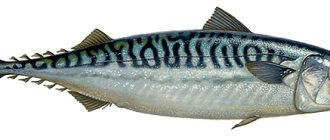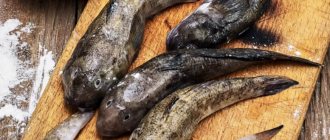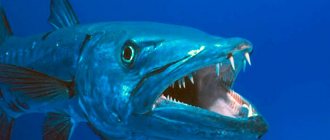Bleak (bleak, sebel) is a small, agile, agile freshwater fish that lives almost everywhere in water bodies in the middle zone. Characterized by a pelagic lifestyle.
Bleak, apparently, is one of the fish that has a lot of other names depending on the zone of its habitat. There are shackley and shackley and buckley/baklya, and sebil and sybil, and selyavka and sintya... A relatively complete list can be found below, bleak is small, but a very diverse fish, including in its nicknames.
Bleak fish: general description with photos, alternative “nicknames” for the little fish
Bleak is a common fish belonging to the Karpov family. It has a shiny, pronounced pelagic coloration: the ventral part and sides are light, silver, and the back is darkish, gray, with a greenish tint.
Translucent fins of an ashen, grayish or yellowish tone. Metallic scales. The color changes depending on the transparency of the reservoir. The short, elongated body is characterized by slenderness and laterally compressed. The average length of the bleak is 12-15 cm, but in exceptional cases it can reach 25-30 cm.
Body weight on average varies from 40 to 60 grams, the largest specimens can weigh 80-100 grams. Lives approximately 5-6 years, but sometimes lives up to 10 years. If a body of water is full of predators, the lifespan of bleaks is reduced to 3-4 years. The peculiarity of the fish is that its scales are easily separated from the body upon contact with a hard surface, so it is quickly and easily cleaned.
There are a lot of synonymous names. In Russia, fish has more than 20 names. A large river or region gives its own name to the uklee:
- In Orenburg and in the region it was nicknamed whitefish, white-eye and blue-eye;
- In Astrakhan - twitcher;
- In Samara - chebanchik or chebak;
- In the Penza region - kalinka;
- In Saratov - bakleshka;
- In Tver and Serpukhov - the top-melting fish and the red-headed fish (which is not entirely true, this is a different fish, although very similar to bleak);
- On the Kama River it is called shakleyka;
- On Vyatka - shakleya;
- In the Urals - groom and harmak;
- On the Upper Volga - mudflow;
- On the Oka - sikla;
- On the Desna and Seimas - sebel;
- On the Dniester there is Sweden.
Selyavka, sebel or bleak - which, however, is the same thing
Description of types of buckle
The genus Alburnus (bleak) has up to 45 species. A well-known species is the common bleak (Alburnus alburnus). Its description is given above. A characteristic feature that can be used to distinguish one species from another is the number of scales in the lateral line. For common bleak it is 45-55 pieces. There are many endemic species in the genus Alburnus that live only in a specific body of water.
Common bleak
The following types are well known:
- Danube bleak or Caspian bleak (Alburnus chalcoides) differs from the common species in its larger size: body length averages from 15 to 30 cm, and sometimes 40 cm. The number of scales on the lateral line varies from 57 to 70 pieces.
- Caucasian bleak (Alburnus Charusini) - the body size is smaller than that of an ordinary bleak, and is no more than 10 cm. It is difficult to distinguish externally from the known species. There are 41-45 scales along the lateral line.
- The Azov-Black Sea shemaya (Alburnus mento) is a rare species that can grow up to 35 cm. The standard weight of individuals is 200-250 grams. It differs from ordinary bleak in the orange color of its pectoral fins, wider body and dimensions. There are 64-70 scales on the lateral line.
Large bleak shemaya
The difference between bleak and adjacent and similar fish
Adult specimens of verkhovok and bystryanka are very similar to bleak. Some fishermen often confuse small dace with bleaks.
The body of the bystryanka is higher and shorter than that of the bleak. Her mouth is semi-lower, and her bleak is semi-upper. The number of scales on the lateral line in bleaks is 45-55, and in bystryanki - 44-52.
The body of the verkhovka is narrower than that of the bleak. Its eyes are located at the top of its head, while the bleak's eyes are located on the sides of its head. The verkhovka has an upper mouth shape and a blunt stigma, while the bleak has a pointed one. Its lateral line is incomplete and has no more than 14 scales.
Another similar fish to the bleak is the dace, but it differs from the bashkleika in the semi-inferior type of mouth and the slightly cut out shape of the anal fin.
Similar fish, especially in small sizes
Interesting fact
Oriental essence was extracted from bleak scales in France and used to color artificial pearls. This method was first developed in China, hence its name. The point is that a large amount of scales was placed in water, stirring until the silvery film separated and settled to the bottom. Then the scales were removed, most of the water was drained, and the silvery liquid, cleared of impurities, was mixed with fish glue. The resulting composition was used to make high-quality pearls.
Habits and lifestyle depending on the season
During the warm period, the fish stays in the upper layers of water, at a depth of 50-70 cm. It moves around the reservoir in schools.
Active behavior: tickling is constantly in motion. Feeds throughout daylight hours. In the mornings and evenings it hunts small insects on the surface of the water, snatching them in flight and jumping out of the water. On rainy and cloudy days, the bleak behaves similarly, grabbing midges and mosquitoes flying close to the surface of the reservoir. There is no activity at night.
As the weather gets colder, the sintha gradually goes deeper. In winter, it does not feed, falls into a state of torpor, while being in the pits. When the thaw arrives, activity increases slightly. Fishing in winter is ineffective.
Lots of bleak
Spawning features
Sexual maturity occurs at 2-3 years. The minimum water temperature for breeding is +15 0C. The process begins in May and continues until early July.
Spawning grounds are calm shallow areas (10-50 cm) with the presence of underwater vegetation. Sandy and pebble shallows and rocky soil are rarely chosen for spawning.
Egg laying occurs in portions: 3-4 times. In warm weather, the break between approaches is several days, and in cold weather, the spawning process can last for a month or more.
Spawning sessions are often repeated approximately two weeks later. The older large individuals spawn first, followed by the young ones. During the process of laying eggs, they behave violently, jumping out of the water. Sticky eggs attach to plants, rocks and driftwood.
Fecundity is high: 300-400 eggs are formed per 1 gram of body weight. One clutch includes from 3 to 5 thousand eggs.
The incubation period lasts about a week. The size of hatched babies does not exceed 4 mm. By autumn, the length of the fry reaches 3-5 cm.
What does bleak eat?
The diet is omnivorous, but food of animal origin is preferred. There are no seasonal preferences. Mostly zooplankton is consumed: fry, crustaceans, worms, caviar, larvae. The fish also loves small insects: mosquitoes, midges, flies, centipedes, honeydew, stem beetles, midges and others. Minor food includes small algae, seeds, maggots and pieces of bread. The last two are used in fishing as bait.
In summer, food is absorbed from the surface of the reservoir, and in winter - in deep places at the bottom. The places where the fat is found are thickets of vegetation, river mouths, areas behind rifts and along the banks with bushes hanging over them.
Nutrition
As you can see in the photo above, the high water fish is small and stays closer to its relatives. They also prefer to feed in flocks. This order of the carp family has an enviable appetite. A favorite delicacy is flies and other insects flying over the pond. The fish stays near the surface and it will not be difficult for it to quickly grab an insect that has fallen into the water.
Interesting fact! When it comes to feeding, it does not disdain caviar and fry of other fish: crucian carp, minnows and its own.
The main food is:
- crustaceans;
- plankton and zooplankton;
- rotifers;
- insect larvae and adults
- algae, if nothing else is found for the fish.
They spend most of their lives in search of food.
How to catch sebel
Where can I find bleak?
Bleak is found in many bodies of water. Prefers flat rivers with moderate currents. Found in flowing lakes, reservoirs and small streams. The selyavka is able to withstand the brackish water of river mouths. In slow currents it groups near piers and bridges.
It is not afraid of people: it swims up to places for swimming and resting. It does not swim far from the shore: in the coastal zone it must be looked for at a depth of 70-100 cm. In spring, bleak must be looked for in illuminated and warmed places, especially where there is vegetation.
The fish does not inhabit mountain rivers with very fast flows, stagnant lakes and ponds and overgrown reservoirs.
Sebel is a small fish, but ubiquitous in the middle zone, and therefore interesting to catch.
Advice! To find out whether the sybil is present in the reservoir, just look closely at the shore, since it prefers to feed along the shore. If you throw a piece of bread into the water, the flock will immediately expose itself.
Necessary gear
As a rule, when catching bleak, a regular float rod is used. Important! The tackle should not be heavy:
- The main line should be no thicker than 0.15 mm, on average its thickness is 0.12-0.2 mm, and the size of the leader line can vary from 0.08 to 0.1 mm. The diameter of the leader should be larger than the main line. Its length can be 15-30 cm.
- The hook should be no larger than No. 14 in accordance with the international classification. The shank of the hook should be elongated.
- pellets as weights, with the largest being installed first from the tip of the rod.
- Floats are used with a long antenna and a short keel, weighing from 1 to 3 grams. The antenna should protrude a quarter or a third above the surface of the water. The most proven floats are elongated and short teardrop-shaped ones. Please note that the floating object (the lower part of the float) should be chosen in a dark color, because this fish “hits” bright colors.
A comfortable and lightweight classic fly rod with a length of 2.5 to 5 meters is used. The plug fits well. Fishermen often use long reeds, cut directly on the pond, instead of fishing rods. You can also catch bleak using a net.
All equipment elements should be as light and thin as possible.
Autumn bleak fishing:
How to fish: technique, tactics, bait and advice from fishermen
Experienced fishermen, in order to attract the attention of the riding fish, scoop up water with their palms and throw it to the place of the float. In accordance with their recommendations, during a break in fishing or while changing gear, complementary feeding should not be stopped.
Pot-bellied bashley is a decent catch, especially for beginners
The bleak bites periodically.
It is interesting to know that the bait is thrown a little higher upstream, and the gear - lower.
When the bite stops, it is necessary to reduce the intensity of the bait, after which the bite will resume. When the bite increases, they do the opposite.
The gear should not be cast deep. It is much more effective to catch bleak in the spring, in the evening and morning hours. You should cast the fishing rod noisily and sharply: the top swimmer will react to the splash and rush towards it.
Attention! The buckeye bites sharply, so the angler must have an immediate reaction.
In cold weather, bleak is caught well at the end of winter, during the thaw period. Finding it at this time is not easy: it can live at the bottom, at the edge of the ice or in the middle of the depth. You can't do without complementary foods here.
The fish is not picky. The bait for bleak should be small in size. The use of the nozzle depends on the season:
- In the spring, the silyavka is lured with a small worm, caddisfly, bloodworms and maggots, which should be white. The fish does not consume plant food at this time.
- In the summer , bleak feeds on plant products; even bread crumbs will be pecked. You can use semolina mash.
- In autumn , the fish bite weakly, so the diet should be comprehensive, including food of plant and animal origin. Maggot with pearl barley works well.
- In the winter season, burdock and bark beetle larvae serve as excellent bait for catching bashklei.
How to catch a large sebeli:
Lure
It is necessary to use bait in order to keep the fish in a specific place.
When purchasing bait mixture, you can choose any brand, but it is important that the bait be finely dispersed. In order for the mixture to create cloudiness, it must be over-moistened during the mixing process. You can add milk powder in the amount of 100 grams per 1 kg of bait.
You can make the bait yourself. Bran and breadcrumbs are mixed. They should first be ground in a coffee grinder. To attract fish, the mixture includes an aromatic additive: strawberry, pear, vanilla and dill oil. Water is poured into the resulting bait and balls are formed from it.
The colder the air temperature, the more bleak needs food of animal origin. At this time, the bait is mixed with bloodworms.
Catching bleak on a fly rod - video from experts:
Habitats
Bleak can be found in almost any body of water that does not have a strong current and does not have strong vegetation. The temperature of the water is not important for such individuals. They adapt to different temperatures. Bleak can live peacefully in both cold and warm water. The bleak's most favorite habitat is shallow, lowland rivers that have gently sloping banks.
Note! Fish of this species cannot tolerate water that is not overly saturated with oxygen. Therefore, it is quite difficult to find it in lakes and other bodies of water with stagnant water.
This freshwater fish can be found mainly in the European part of the country. It also lives in small numbers in Asian river bodies. The main habitat of the hive is the rivers and lakes that are part of the Baltic and White Seas. You can also find her in:
- Finland.
- Poland.
- Baltics.
- Tributaries of the Irtysh and Iset.
Some fishermen encounter this fish on the Ural slopes, but in scanty quantities. Until now, many scientists do not understand how these small river inhabitants managed to get to the Urals and pass through the mountain ranges. Bleak often swims near the surface of the water, which is why people notice it on piers and bridges. On especially warm days, individuals prefer to swim away from the coastal zone of the reservoir. In the evening, when the heat subsides, they again swim closer to the shore. This fish prefers flowing shallow reservoirs with little current. But it also easily lives in places with an impressive current, as it quickly adapts to it.
Using bleak as live bait
Bleak is used as live bait when catching predatory fish: pike perch, asp, pike and perch. However, it has low endurance. For this reason, it is necessary to frequently check the condition of the fish that is hooked.
If fishing is carried out in the current, the bleak is hooked to the lip on a tee or a sharp hook, and if on a lake, the sting is passed under the fin located on the back. It is important not to damage the spine. The condition of the fish is noticeably better when the leash is passed under the gill cover into the mouth, while the bends of the hook should rest against the edge of the cover. With this approach, it is not damaged, remains alive longer, and sits securely on the hook. This is the best way to apply the nozzle.
When storing live baitfish at home, the container in which they are kept should be supplied with air using an electric microcompressor. You need to change the water in the container as often as possible. When transporting live bait, it is necessary to periodically pump up the air using a rubber bulb.
Live bait from sebael is not the best in terms of survivability, but if you use it immediately after catching it will do
Economic importance
Verkhovka is one of the smallest fish living in fresh waters, so it is not of interest for industrial fishing. Refers to weed varieties. It is mainly used as bait for catching large inhabitants of the reservoir. Amateur fishermen do not consider them to be serious prey, but having found a good place where they gather, they will not miss the opportunity to catch small fish with a net for dinner.
It is important to note that it is not recommended to give raw food to domestic cats; river fish contains more parasites than sea fish; this species is known as a carrier of the cat fluke, a parasite that affects the liver.
Taste qualities
Fish meat has excellent taste. Moderate fat content gives dishes a delicate taste. Bleak is especially tasty when dried. The most delicious bleak is considered to be the one caught in August or September. In some European countries (Montenegro, for example), fried bleak is a delicacy served in restaurants.
Benefits and calorie content of meat
Fish has a high content of minerals and substances that have a beneficial effect on the body. The most important of them: magnesium, zinc, potassium, molybdenum, fluorine.
Bleak is useful for those who watch their figure. Eating it is recommended by nutritionists, since the fat content is only up to 12%, and the calorie content when fried and boiled is 145 and 95 kcal, respectively.
Dietary bleak meat
How to cook bleak tasty and quickly - recipes
Cooking the fish differs depending on its size.
Small fish, not exceeding 10 cm in length, are salted by adding black pepper, cloves, basil and spices, and left for 24 hours. An average bleak, the size of which is 10-12 cm, sits for a day with the addition of bay leaves, black peppercorns and a small amount of sugar. After this, the fish is hung on a thread in the shade.
After salting, large bleak is laid out on layers of newspaper and turned over 2-3 times a day for several days.
It’s easier to prepare: pour two handfuls of salt into the bottom of the container and put the catch there. After some time, the fish must be dried.
How to quickly and deliciously prepare bleak/silavka - video recipe:
Thus, whitefish can be found in many bodies of water characterized by moderate and calm currents.
You can distinguish the headfish from similar fish by the number of scales on the lateral line, the shape of the body and mouth.
Bleak is a very tasty, healthy fish. The fish is schooling, so you can catch it quickly. In this case, you should definitely take into account all the features of fishing: use light tackle, cast the fishing rod sharply, feed and attract the attention of the fish, instantly respond to a bite.
Other names
This fish has other names. In addition to the everyday name - bleak, it can be found under such names as silyavka, silyava, sentya, sintya, baklya, verkhovodka, selyava, sebel, sibel, sibil, shchekleya, bakleshka. bashkleya, shakleya and top melting. Sometimes it is incorrectly called by the names of other fish:
- chebak;
- sprat;
- white-eye;
- verkhovka;
- Bystryanka











